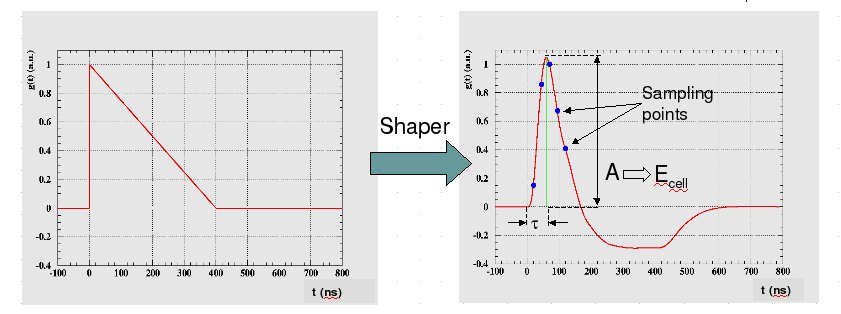 Calorimeter Calibration
Calorimeter Calibration Calorimeter Calibration
Calorimeter CalibrationCalorimeter resolution is given by:

Need to have 1% energy resolution on a light Higgs mass in the H → γγ or H → 4 e decay channels.
Note: information found here is based on the 2006 Atlas note by M. Aleksa et al., ATL-COM-LARG-2006-003 and the Calibration Tutorial given by Marco Delmastro.

Fig.
1 Right: Ionization (physics) pulse. Left: Physics pulse at the
output of the shaper (see Fig. 4).
Points corresponding to the sampling steps are also shown.
The energy deposited by the physics pulse is found from the following equation (cf. Fig. 3):
Isn't the simplest way of calibrating the calorimeter to send particles with known energy and see what we actually reconstruct?
This, in fact, is done during test beam. However, we cannot
test every calo cell this
way, only a small fraction in a calo mock-up. The way to do it is to generate pulses using a pulse generator
(DAC). These calibration waveforms
will
simulate the physics pulses.
We use the following formula to find the energy (remember that
this is, in a sense, "simulated energy") corresponding to the calibration wave (cf. Fig. 2):
 |
The sequence to predict a physics pulse from the calibration pulse is the following:
Scale the calibration wave so that its max. amplitude is 1 (done for TCM method, below). Alternative method is to scale the amplitude of the physics wave to 1 (done for RTM method, below). Mphys/Mcali refers the the ratio of the physics to calibration amplitudes, which corrects the for the difference between the calibration and physics signal heights in the TCM. In the RTM method it is absorbed into the calculation of ADCpeak, thus is not computed explicitly.
Find the predicted physics wave. This is done by one of the two complementary methods: TCM and RTM. The real physics waves produced during test beam are either used directly in the prediction (TCM) or, indirectly, to compare it with the predicted wave (RTM).
Find the ADCpeak using Optimal Filtering
Coefficients (OFC's).
Alternative methods of computing the ADCpeak,
such as the parabolic interpolation and through Pseudo-Optimal
Filtering Coefficients, also exist.
Convert ADC to DAC using the ramp relationship. Σj is given by this formula in the ramp relationship. Rj are second order ramps resulting from the A-to-D conversion.
Compute FDAC->μA factor. FDAC->μA = 76.295 μV/Rinj where Rinj is the value of the injection resistor on the calibration board.
Compute FμA->MeV factor. The meaning of FμA->MeV factor is explained here [PS file].


DAC values are chosen in such a way as not to saturate the
ADC. Typically, 16 DAC values were used, making the total number of
pulses per cell 16 × 100 = 1600.
DAC = 0 was also used to study the possible effects of the
parasitic injected charge (typically around 1 ADC count). See also ramps.
ADC value of each of the N
samples is read out and the mean and the RMS values are computed. The
averaged waveform for a given DAC value are called Master
Waveforms.
The averaged samples are arranged in time according to the delay
value. Thus an averaged profile of samples spaced by 1 ns is
obtained, yielding the complete waveform. The total number of samples
was 27 and the total waveform was 648 steps long.
LArCalorimeter/LArCalibUtils/LArCaliWaveBuilder is the corresponding offline simulation
package.During Test Beam only HIGH and MEDIUM (100 and 10) gains were utilized since the beam energies were never low enough to trigger the LOW gains.
LArCalorimeter/LArCalibUtils/LArPhysWaveBuilder is the corresponding offline simulation
package.